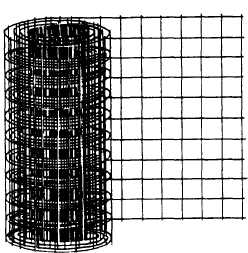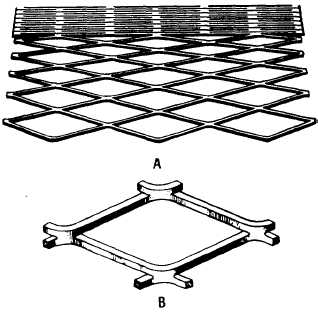beam and girder bars, bends for reinforcement
of vertical columns at or near floor levels,
stirrup and column ties, slab reinforcement, and
bars or wire for column spiral reinforcement.
SPLICES.— Where splices in reinforcing steel
are not dimensioned on the drawings, the bars
should be lapped not less than 30 times the bar
diameter, nor less than 12 in. The stress in a
tension bar can be transmitted through the
concrete and into another adjoining bar by a lap
splice of proper length. The “lap” is expressed
as the number of bar diameters. If using the
No. 2 bar, make the lap at least 12 in.
EXPANDED METAL AND WELDED
WIRE FABRIC.— Expanded metal or wire mesh
is also used for reinforcing concrete. Expanded
metal is made by partly shearing a sheet of steel,
as shown in figure 7-13, view A. The sheet steel
has been sheared in parallel lines and then pulled
out or expanded to form a diamond shape
between each parallel cut. Another type is square
rather than diamond shaped, as shown in figure
7-13, view B. Expanded metal is frequently used
during plastering operations.
Welded wire fabric is available both in rolls
(fig. 7-14) for light building construction and
sheets for highways and use in buildings when roll
sizes will not give ample reinforcement. Wire
Figure 7-13.-Expanded or diamond mesh steel reinforce-
ment.
Figure 7-14.-Welded wire fabric.
fabric is furnished in both square and rectangular
patterns, welded at each intersection. The rec-
tangular sizes range from 2 by 4 in. to 6 by 12
in. The square patterns are available in 2 by 2 in.,
3 by 3 in., 4 by 4 in., and 6 by 6 in. Both are
furnished in a wide variety of wire gauges. The
square pattern has the same gauge in both
directions, while the rectangular type may have
the same gauge in both directions or the larger
gauge running longitudinally. Specifications and
designs are usually used when wire fabric (mesh)
is being lapped; however, a minimum of 2 in.
between laps is usually sufficient.
Reinforcing bars can be joined together by
different types of ties. Figure 7-15 shows six types
used by the SEABEEs.
PRECAST CONCRETE
Precasting is the fabrication of a structural
member at a place other than its final position
of use. It can be done anywhere, although this
procedure is best adapted to a factory or yard.
Jobsite precasting is not uncommon for large
projects. Precast concrete can be produced in
several different shapes and sizes, including
piles, girders, and roof members. Prestressed
concrete is especially well adapted to precasting
techniques.
Generally, structural members including
standard highway girders, poles, electric poles,
masts,
and building members are precast
by factory methods unless the difficulty or
7-10




